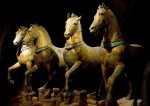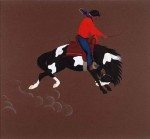by Marsha Qualey
 The Horse: A Celebration of Horses in Art
The Horse: A Celebration of Horses in Art
Rachel Barnes and Simon Barnes
Quercus Publishing 2008
“We paint what matters to us…”
“Horses have always been part pf the human imagination”
—from the introduction
…
While preparing for this month’s Bookology I read and looked at many books about horses, and this is the one that was totally (totes!) unexpected. I was wowed. Even better, after an initial perusal I felt compelled to page through it again and again, studying the text and savoring the images.

Lascaux, France
Click to enlarge.
In art, paintings over a certain size are classified as “monumental.” This is a monumental book, 17’’ (h) x 14” (w). Accordingly, the reproductions — many on double page spreads — are much larger than any that could be viewed on a computer screen; further, the paper and image quality successfully convey the tactile element of the artwork.
The price tag is also monumental; that along with the size would make this book a questionable one to add to a school library or a personal collection, but its impact as a classroom or living room visitor is easy to imagine.

St. Mark’s Basilica
Venice, Italy
Click to enlarge.
History? You bet. The book is organized chronologically, from the cave painters to Picasso. How did the human relationship to horses change? Why? How did those changes show up in our art?
Science? You bet. The green patina on the bronze horses at Saint Mark’s in Venice is enough to trigger many conversations about basic chemistry and pollution.

Los Angeles, California USA
Click to enlarge.
Language arts? You bet. Begin with Paulus Potter’s painting, “The Piebald Horse.” Piebald. This veteran writing teacher smiles at the idea of using the word as a prompt for any number of writing exercises.
Of course, there would be some classroom cautions should the book be shared that way. Because the focus is on Western art, the early sections include a fair amount of Christian imagery. And — yet again — most of the (known) artists are white men.

The exceptions to the white-guys trope are fabulous, though, and they should be added to any list of report-worthy individuals:
Rosa Bonheur (The Horse Fair, left): “In order to make studies at the horse sale in Paris she obtained police permission to dress up as a man, so she could move more easily around the crowd” (p.123).

Velino Shije Herrera (Bronco Busting, right): “Herrera was born in Zia Pueblo in New Mexico. He became recognized for his quotidian scenes of the Pueblo Indian Life … this work is signed with his Native American name Ma Pe Wi” (p. 184).
One final warning: this is not a lap book. To savor it you will need a table and time.
